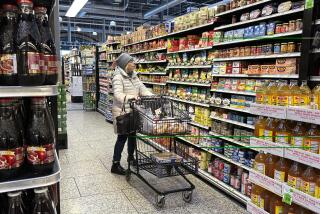Flood of Imports Into Argentina Delights Shoppers, Riles Local Industry : Trade: As tariff walls fall and the exchange rate holds steady, consumers are snapping up products from abroad.
- Share via
BUENOS AIRES — Color TVs from Hong Kong. Espresso makers from Germany. Sardines and red wine from Spain. Swiss cheese.
A trickle of imports has turned into a flood in Argentina as tariff walls come tumbling down and the exchange rate holds steady after years of constant devaluation.
Local manufacturers are grumbling about the new competition from outside, but shoppers are delighted.
“The preference for imported goods should be a lesson for Argentine manufacturers. Now they realize they have to make things better and charge less,” said Ana Segovia, who bought six pairs of nylon stockings from Korea for $5. Locally made stockings might easily cost twice as much and last only half as long.
Like many nations in Latin America and the Third World, Argentina has long relied on high import tariffs to boost production by local industry.
That strategy ended under President Carlos Menem. Since he took office in July, 1989, the average tariff has been slashed by more than one-half to 12%. The maximum tariff is now 35%, and that’s only for a handful of electronic and automotive goods.
By comparison, several years ago the tariff on calculators was 1,078%, or nearly 11 times the cost, said Abel Viglione, a senior economist with the Latin American Economic Research Foundation.
Results of the protectionist policy were mixed. Local industries produce sophisticated goods such as steel, glass, plastics, cars, planes, stereos, medicine. But much is relatively expensive and of low quality.
A three-speed bicycle might cost $200 and begin to rust the first time it rains. A double bed can cost more than $800. Some refrigerators resemble old-fashioned ice boxes.
President Menem and Economy Minister Domingo Cavallo decided that the costs of protectionism outweighed the benefits. In addition to lowering tariffs, they lifted bans and quotas on 4,000 products. Now only cars are protected by quotas.
The goal is to expose local industry to competition gradually, so that manufacturers improve production and don’t simply go out of business, as happened during the last great opening in 1978-81.
During that period, local manufacturers were hampered by an artificially strong exchange rate and could not compete in terms of price or quality. Without quotas, for example, car and truck imports surged from 458 in 1978 to 11,279 in 1979 and to 68,361 in 1980.
When the exchange rate suddenly devalued and controls were reimposed, vehicle imports shrank to 987 in 1983.
Now business is wary of the new policies.
“You have to be careful because national industry is at risk,” said an official with the Argentine Industrial Union.
But some industries are adapting. Local auto makers, for example, plan to build 204,000 cars in 1992, up from 140,000 in 1991 and 100,000 in 1989.
Meanwhile, imports increased by 90% in the first eight months of 1991. A trade surplus of $8.3 billion in 1990 was projected to shrink by half in 1991.
Much of the imports are consumer goods, with textiles and electronics leading the way. By year’s end, textile imports were expected to reach $300 million, more than three times the total in 1990. “That means of every five articles of clothing (sold), one is imported,” said Jesus Fabeiro, vice president of the Assn. of Textile Industries.
Electronics imports are way up too. Between April and May, 1990, 65,000 television sets were imported, according to the Assn. of Electronic Article Makers. In the same period of 1991, 377,000 TV sets were imported.
The holds of ships and planes are crammed with copy machines from England, cotton scarves from India, peaches from California. More boxes are filled with tape recorders and cassettes, scissors and knives, pocket calculators, condoms, cards and toothpicks.
The firm Edcadassa oversees the goods while they await inspection by customs officials at Ezeiza international airport. Company officials said the daily inflow averaged 60 tons two years ago. Now it’s 150 tons.
“Due to the great demand that exists, importers get their merchandise out of deposit as fast as they can with the intention of taking advantage of the good moment to sell it,” said a company official who would not be identified.
Perhaps to be expected is the fact that contraband is way up too. The federal police report they seized merchandise worth $120 million from January to June of 1991 from people crossing the border from Paraguay, Uruguay, Chile and Bolivia.
The items included 17,000 packs of cigarettes, 19,000 cassettes, 4.8 million condoms and three dozen electric toothbrushes.
More to Read
Sign up for Essential California
The most important California stories and recommendations in your inbox every morning.
You may occasionally receive promotional content from the Los Angeles Times.









